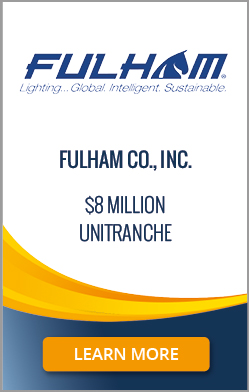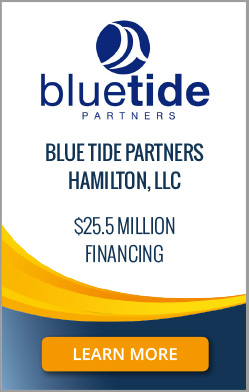Senior Stretch Loans: A ‘Big Company’ Solution for Private Companies
Private enterprises are increasingly benefiting from facilities that combine senior and mezzanine debt, formerly the preserve of larger enterprises, to provide more needed capital at lower prices
By Jeffrey Sweeney, Chairman and CEO at US Capital Global
 The financing options available to private businesses have steadily been increasing, but not from traditional banks but rather from alternative lenders. Traditionally, small to lower middle market companies—those with $5 million to $300 million in annual revenues—relied on an asset-based revolving line of credit together with term loans, depending on the nature of their business. Generally, the revolving line of credit was secured on accounts receivable and inventory, and the term loan on plant and equipment. Adding to this traditional financing arrangement, alternative lenders are providing cash flow lending as well, sometimes at quite moderate prices.
The financing options available to private businesses have steadily been increasing, but not from traditional banks but rather from alternative lenders. Traditionally, small to lower middle market companies—those with $5 million to $300 million in annual revenues—relied on an asset-based revolving line of credit together with term loans, depending on the nature of their business. Generally, the revolving line of credit was secured on accounts receivable and inventory, and the term loan on plant and equipment. Adding to this traditional financing arrangement, alternative lenders are providing cash flow lending as well, sometimes at quite moderate prices.
Increasingly non-bank lenders have been stepping in to provide financial products that offer new levels of flexibility. Their offerings now actually represent an expansion on traditional lending to smaller businesses.
Small and medium-sized businesses (SMBs) often require additional capital over and above what commercial banks are able to provide on their own. Often these businesses require a mix of financing, intelligently structured to meet their specific needs. The small-cap and lower-middle-market lending space is made up primarily of single-product lenders. Therefore finding the most appropriate mix at the best cost, and then coordinating the different specialty lenders to a successful closing, can be a difficult process. As a result, SMBs have increasingly been setting their sights on ‘unitranche’ financing, formerly the preserve of mainly the upper end of the middle market.
What Is Unitranche Financing?
Unitranche loans, also known as ‘senior stretch,’ blend senior debt and junior or mezzanine debt into a single facility. Rather than approach a senior lender, typically a bank, and then also one or more additional junior lenders, a borrower with a unitranche structure has a single secured loan facility, with all the debt subject to the same terms. These ‘syndications’ between alternative lenders or mezzanine loan providers and commercial banks or low-cost asset-based lenders can provide a less costly ‘blended’ rate for borrowers.
First created in 2005, unitranche loans were used primarily for transactions on the higher end of the middle market, by borrowers with annual EBITDA of at least $50 million and sales of more than $500 million. Unitranche loans are still used primarily to fund leveraged buyouts, and in many cases these are private equity-backed acquisitions. A deal size of about $100 million is still fairly typical. Until recently, this has placed unitranche facilities outside the reach of smaller businesses. Today, however, non-bank lenders are increasingly using this hybrid loan structure in the small and lower middle market, in place of or in conjunction with traditional bank financing.
A unitranche loan is divided into distinct first loss and second loss components. The relationship between the two lenders is negotiated through an intercreditor agreement that lays out the rules of the relationship and the rates of return between the lenders. In the event of borrower default, the lenders act as one entity and clearly know where the other stands. From the borrower’s perspective this is largely irrelevant, though. This is because a unitranche loan is structured as a single debt instrument, with all the debt subject to the same terms. Unitranche loans also have a single ‘blended’ interest rate: one that falls between the separate rates applicable to the senior and junior components of the loan.
Advantages of Unitranche Financing
Unitranche structures can have significant benefits for the borrower. These benefits spring from having a single creditor agreement and single interest rate, and often also a single lender point of contact. This provides a streamlined process for ongoing administration and decision-making, with covenants becoming simpler to report and administer.
Dealing with multiple lenders takes time, especially if the borrower is negotiating separate first and second lien facilities. With unitranche loans, there is no need for the borrower to mediate intercreditor agreement negotiations between senior and junior lenders. This reduces the risk of the deal falling apart. It also makes speeds up the time to close, making a unitranche solution especially suitable where speed is often of utmost importance, such as the financing of an acquisition.
In a unitranche structure, if the borrower requires permission to depart from the terms of the loan agreement, the lender is more likely to agree. In a traditional loan structure, it can be challenging for a borrower to obtain a waiver or consent from separate first and second lien lenders. This is because these lenders may be disparate groups with different motivations. They may have limited interest in the borrower’s day-to-day business affairs. With no competing interests between lenders, unitranche financing also eliminates expensive legal posturing and duplicate default work with the borrower by competing legal counsel. This can result in higher loan amounts because of ‘comfort’ in the absence of competing interests.
An Insider’s Perspective
At US Capital Global, a full-service private financial group based in San Francisco, we have witnessed rising demand for unitranche solutions from SMBs since we started offering this alternative. For instance, the firm has structured and provided capital for a custom $8 million unitranche facility for a leading global supplier of energy-saving LED products. The new unitranche structure replaced a traditional bank loan and provided the company with new capital to pursue a strategic acquisition in Holland, as well as additional working capital for its current and future needs.
Similarly, the US Capital Global team provided a multi-million dollar unitranche facility for a leading medical implant company. The financing comprised an accounts receivable and inventory revolving line of credit for both domestic and international assets together with a cash-flow term loan. Previously, this medical implant business had separate senior and junior lenders. The new unitranche facility, which combined the senior and junior debt, resulted in a lower blended cost of capital and higher availability because of the reduced risk of lender contention. It also made it easier for the company to access additional follow-on financing going forward.
The small and lower-middle-market lending marketplace continues to be highly fragmented. Specialty lenders are generally willing to lend only against their favored asset class. Finding the most appropriate mix of financing at the best cost, and then coordinating the different specialty lenders to a successful closing, can be a challenging process for an SMB. Innovative non-bank lenders now have the ability to provide a single, unitranche loan to vastly simplify the situation. Once a financing solution primarily for larger businesses, unitranche loans now offer SMBs the advantages of speed, simplicity, and certainty of closing.
Example Transactions
Click on the tombstones below for further details about these selected transactions.
 |
 |
 |
 |
 |
 |
Jeffrey Sweeney is a fund manager with years of experience in corporate finance and asset management. He is Chairman and CEO at US Capital Global (www.uscapglobal.com), a full-service global private financial group headquartered in San Francisco.
Securities offered through US Capital Global Securities, LLC (“USCGS”), member FINRA/SIPC. This is for your information only and is not an offer to sell, or a solicitation of an offer to buy any securities or instruments. Any such offer or solicitation shall be made only pursuant to the confidential private placement memorandum and supporting documents, as amended or supplemented from time to time. The information has been obtained or derived from sources believed by us to be reliable, but we do not represent that it is accurate, complete, or timely. Any opinions or estimates contained in this information constitute our judgment as of this date and are subject to change without notice. USCGS or its affiliates may provide advice to, be compensated by, or hold debt or equity positions in the companies noted herein. View USCGS’ Form CRS at www.uscgs.com/crs.html. 07222021-FA-VG
![]() Download a PDF of this Press Release
Download a PDF of this Press Release